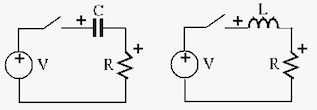Next: Homogeneous Solution Up: Chapter 3: AC Circuit Previous: Impedance and Generalized Ohm's
In the previously discussed method for AC circuit analysis, all
voltages and currents are represented as phasors and all circuit
components (R, C, and L) are represented by their impedences,
so that we can solve the corresponding algebraic equations
to get the steady state responses of the circuit to an AC
voltage or current input. However, if we are also interested in
the transient response of the circuit to an input which is
turned on at time moment 
As a simple example, the RC circuit shown below is composed of a
resistor 











As shown in the figure, the polarity of 

 |
(68) |
 is the time constant of the system with the
dimension of time:
is the time constant of the system with the
dimension of time:
![$\displaystyle [RC]=\frac{[V]}{[I]}\frac{[Q]}{[V]}=\frac{[Q]}{[I]}=[T]$](img244.svg) |
(69) |
 or or |
(70) |
 is the time constant with the dimension of time:
is the time constant with the dimension of time:
![$\displaystyle \frac{[L]}{[R]}=\frac{[V][T]}{[I]}\frac{1}{[R]}=\frac{[R][T]}{[R]}=[T]$](img248.svg) |
(71) |
In general, a first-order linear system with input


 |
(72) |
 .
.
The solution of a DE represents the response (or output) of the circuit to both the external input and the initial state, and is composed of two parts: